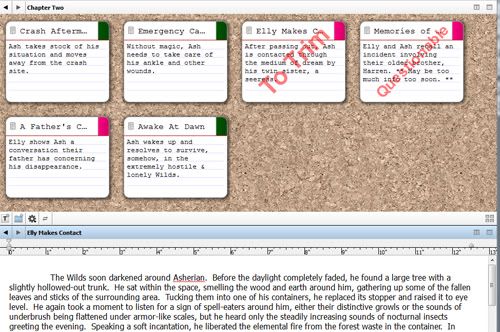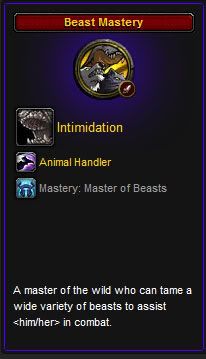The Beast Mastery Tree
Right from the start, it’s clear that Blizzard has tailored this talent tree to focus just as much on the pet as it does on the Hunter. And this is also the only signature ability of the talents that is not a shot. Intimidation is rather a pet ability with a two-fold purpose. It causes threat, for those pet tanks we use while soloing, and a 3-second stun, which is useful for crowd control and especially in PvP. The more stuff you can throw at someone to lock them down so you can fire off more damage the better. This does have a 1-minute cooldown, so use it wisely. Animal Handler increases you Attack Power, and remember that more Attack Power for you means more for your pet. And for Mastery, we have Master of Beasts, which increases pet damage by a percentage with every point of Mastery.
Improved Kill Command
Kill Command is likely to be one of your biggest sources of damage as a Beast Master. This talent increases the chance the pet’s attack will crit, which works well with both the reduced Focus cost that comes from the glyph and talents further down the tree. Considering that Kill Command is still active during Deterrence, this talent is one you’ll want to pick up for both PvE and PvP builds.
One With Nature
This is a decent talent for any build, even if your taste is more towards the other trees. You get more attack power out of Aspect of the Hawk and more focus back from Aspect of the Fox. In situations where your pet is going to be marginalized, such as PvP, this may be a secondary concern for “floater” points in a Marksmanship or Survival build. Beast Masters should definitely be picking this up.
Bestial Discipline
This is another talent that has appeal for multiple builds. Since our pet is a good portion of our DPS, getting them to do damage more often boost our overall output. This talent, coupled with Go For The Throat, increases the Focus regeneration of your pet by quite a bit. Once you get the pattern & rhythm of your own Focus regeneration down, you can pick this up along with Go For The Throat to maximize your pet’s DPS in a raid. PvP builds in other trees may want to go for One With Nature instead.
Pathfinding
More speed from your Aspects of the Daze and when mounted. I guess this would make corpse runs go more quickly. Other than that, I don’t see much value in spending talent points here.
Spirit Bond
Pretty much a must-have for raiding Beast Masters, this talent makes both you and your pet easier to heal. Not only do you and your pet regenerate health, healing done to both of you is boosted significantly. This means healers spend less time and mana healing you, which they’ll surely appreciate.
Frenzy
This talent is an interesting beast. Every time your pet makes a basic attack, it boosts its attack speed. This effect stacks up to 5 times. Your pet may be attacking up to 30% faster after just a few bites and swipes, which not only benefits your output but also ties into a talent on the next tier that I feel no Beast Master should be without. It goes without saying that you should pick this up.
Improved Mend Pet
This is one of those talents that is probably more useful to a soloing Hunter than one in a group be it a raid or a battleground. If you’re in a raid and you need to hit Mend Pet to cleanse or heal your pet, your healer needs to pay more attention. Time you spend mending your pet is time you’re NOT doing damage to the enemy. Anyway, unless you’re soloing, skip this talent.
Cobra Strikes
Another talent that increases the output of your pet, Cobra Strikes grants crits to your pet’s attacks when you hit with Arcane Shot. Since Arcane’s a high-damage shot to begin with, following it with a pair of crits from the pet yeilds much higher numbers. Worth 3 points easily.
Fervor
This is a decent “panic” button for situations where you need more Focus than standing still and casting Steady or Cobra Shot will yeild you. In addition to that it opens up some of the biggest features of the Beast Mastery tree. Even if you never use Fervor to restore 50 Focus to you and your pet, you’ll want to snag this talent.
Focus Fire
When your pet hits 5 Frenzy, you can hit Focus Fire and, in essence, transfer its haste to you. Your pet gets Focus back, you get a boost to your ranged haste (meaning faster Steady & Cobra Shots!) and your pet begins building up its Frenzy again. At one point, you can’t ask for bigger bang for your buck.
Longevity
You Intimidation cooldown is now 30 seconds instead of a minute. Beastial Wrath is ready to use after one minute instead of two. And your pet’s special abilities? Those will happen more often, too. There’s no reason not to drop 3 points in here as soon as its available.
Killing Streak
You’re going to be using Kill Command a lot as a Beast Master. Statistically this means you’ll also have an increased chance of seeing it crit, especially with Improved Kill Command. Killing Streak makes the third Kill Command after back-to-back crits hit harder and cost less. This talent strikes me as another no-brainer for Beast Masters.
Crouching Tiger, Hidden Chimera
This is Beast Mastery’s big PvP talent. It reduces the cooldowns of the skills we need to survive in PvP, namely Disengage and Deterrence, every time we’re hit. If we have a healer, this means we’ll be jumping away and immune to damage more often. Remember how Kill Command is still active during Deterrence? Be prepared for a lot of people raging at you and pick this up for your battlegrounds and arenas.
Bestial Wrath
The big, red kitty remains the lynchpin talent of the tree. For 10 seconds, your pet does more damage and becomes immune to crowd control. Need I say more?
Ferocious Inspiration
At the time of this writing, the Ferocious Inspiration buff isn’t overwritten by anything from other classes. It’s a straight damage increase for all party & raid members. It used to, but now it stands alone. Plus it leads us into another very useful talent. Drop a point here.
Kindred Spirits
This is just about the only means a Hunter has to increase both his own Focus and that of his pet. I know I’m started to sound like a broken record, but more focus means more damage. Absolutely worth its 2 points.
The Beast Within
Big red kitty now triggers a big red YOU. More damage, reduced focus cost AND Terminator-style implacability? Grab it.
Invigoration
Whenever your pet gets a crit, you automatically get some Focus back. Considering how often Beast Masters will want enough Focus to hit Kill Command, it goes without saying that this talent is worthwhile. Everything ties together at this point in the tree, and Invigoration just makes all the other talents and abilities synergize even more coherently.
Beast Mastery
Exotic pets and more skill points. Why would you go Beast Mastery and NOT tame a miniature T-Rex or a ghost kitty or a chimera? Especially now that we have so many stable slots.
While this brings us to an end of the talents for Hunters, there’s one more ability coming our way in Cataclysm.
Camouflage
Here’s what we know so far…
You camouflage, blending into into your surroundings, causing you and your pet to be untargetable by ranged attacks, reduces the range at which enemy creatures can detect you, and providing stealth while stationary.
You can lay traps while camouflaged, but any damage done by you or your pet will cancel the effect. Cannot be cast while in combat. Lasts for 1 min.
I am of the opinion that people’s opinions on Hunters in PvP, that they are “useless” or “pointless”, may change when they start using Camouflage. Ambushes and surprise attacks are unfortunately rare in PvP. With Camouflage, Hunters can now join Rogues, feral Druids in cat form and certain Warlock pets in laying vicious traps for incoming opponents. A well-coordinated group of stealthed gladiators can make things very difficult for the other team. I’m not entirely sure how the mechanics of this ability will work quite yet, but I’m excited to find out.
This wraps up the Hunter in Cataclysm series. I may carve out some time to get a video up with all this information before the expansion hits. Not everybody reads my blog, after all.
Even if they should.







